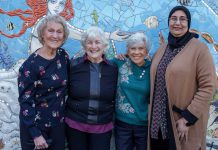When Jenny Bernasky’s mother was dying of cancer in 2001, she
had more to worry about than coping with her own emotions. She had
two young daughters, ages 7 and 9 at the time, who were dealing
with the death of a loved one for the first time.
When Jenny Bernasky’s mother was dying of cancer in 2001, she had more to worry about than coping with her own emotions. She had two young daughters, ages 7 and 9 at the time, who were dealing with the death of a loved one for the first time.
Bernasky received a call – as her mother was in the final weeks of life – from Richard Ingle, a program coordinator with Griefbusters. The Hospice of the Central Coast had referred the Bernasky family to Ingle, who offered immediate grief support for Bernasky’s children who were attending different Hollister schools.
“They came to us,” said Bernasky, who accepted the offer.
Even though Bernasky is a sixth-grade teacher at Spring Grove Elementary School – and experienced with emotional swings of children – she knew some extra help, especially from a nationally renowned grief counseling program, could ease some of the emotional tumult within the family, including her own.
While Bernasky’s mother clung to her final weeks of life, two Griefbusters volunteers – of the 350 across the Central Coast – met the girls in a San Benito High School art room. They didn’t delve into the kids’ minds. They didn’t force the girls to confront their fears. They just talked and painted.
“The volunteers asked questions. … They had the girls remember positive things about my mom,” Bernasky said.
Griefbusters, which was founded in 1984 and serves San Benito and Monterey counties, is one of two unique non-profit programs of its kind in the area. The other is the Centre for Living with Dying, which has served Santa Clara County since 1975. The CLD is the largest grief support agency in the United States and has served more than 800,000 people.
Highly trained Griefbusters volunteers – most of which work at schools as teachers, administrators, even bus drivers and cafeteria workers – are on hand at local campuses if traumatic situations arise for one or more of the children. In the two counties, 80 percent of schools have Griefbusters on staff, according to Program Coordinator Ana Kapoor.
The program, which is affiliated with the Hospice of the Central Coast, has won four national awards and is used as a model for hospices throughout the country, according to Michael Benedetti, director of resource and community services.
“It’s a total community service,” Benedetti said.
He said Griefbusters, which usually performs one-on-one grief counseling, also holds support groups and just last year implemented a Trauma Support Team that goes out when a widespread crisis hits a school.
Benedetti remembers two such cases in Hollister. Several years ago a teacher at Sunnyslope Elementary School died in an automobile accident. And another time, the Griefbusters trauma team went to San Benito High School when a well-known local man died, again in a car crash.
Griefbusters also works with parents, Benedetti said, to teach them how to support a child through the grieving process.
The CLD, unlike Griefbusters, doesn’t focus on bereavement of children. At the historic James Lick Mansion in Santa Clara, eight professional counselors along with more than 100 volunteers regularly meet with clients who are dealing with death.
“It’s very different from therapy,” Executive Director Al Platt said. “What we basically do is train volunteers to deal with grief, to be silent and listen. The presence of someone listening … is very important.”
The CLD, like Griefbusters, does not operate a crisis line and does not consider itself a “24-7 operation.” But he said when a crisis occurs, and the CLD receives a call for help, its trauma team responds as soon as possible.
“In Palo Alto a few months ago, a student stepped in front of a train,” Platt said. “We were there the same day we got a call.”
Platt said the CLD offers several in-house support groups including programs for children, HIV clients and a general support group.
And situations often arise for both the CLD and Griefbusters, after clients receive the grief support, when the same feelings of grief reoccur months, even years later.
Platt said he recently talked to a man whose father died a year ago, who is still grieving over the loss.
“There are no time parameters around the grief process,” Platt said. “Our culture says, ‘Take a couple days off, your report is due Friday.’
“It doesn’t work that way. … You never get over it. You learn to cope with it.”














